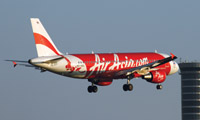Year End Review: Low-Cost Carriers
Headliner scores again
December 1st 2012
Just how does he do it? Where does he get the energy? We refer to AirAsia founder and chief executive, English Premier League club Queens Park Rangers owner and Formula 1 motor racing team Caterham owner, Tony Fernandes. Read More »
 |
| AirAsia: another eventful, headlining year |
For all his diversified interests, Fernandes has, as usual, been rarely out of the news during 2012 as the AirAsia Group has gone from strength to strength.
Not that he has had it all his own way. Fernandes, the pioneer of low-cost carriers (LCCs) in Asia, moved his regional headquarters from Kuala Lumpur to Jakarta, Indonesia, during the year. He launched his seventh no-frills brand, AirAsia ASEAN, to benefit from the 10-nation ASEAN (Association of Southeast Asian Nations) bloc as it moves towards full open skies in 2015. In August, in partnership with All Nippon Airways, he established AirAsia Japan.
But there have been setbacks. At the beginning of the year the group’s long-haul budget carrier, AirAsia X, dropped its services to Europe (London and Paris) and to India as high fuel costs and high taxes took their toll. In May, a share swap deal with Malaysia Airlines (MAS) collapsed following objections from MAS unions.
Fernandes is not a man to let the grass grow under his feet. It was the unravelling of the MAS agreement that prompted Fernandes to head for Jakarta. “ASEAN is a massive market where we only scratch the surface,” said Fernandes. “Our mandate in the next five or six years is to focus on ASEAN.”
To that end he planned to spend $80 million on buying a controlling interest in Indonesian operator, Batavia Air, but the deal fell through in October.
“In hindsight we think management time, the integration, the potential earnings fallout and the huge amount of cash required to turn around Batavia would have been too dilutive,” said Fernandes.
In the future, the hyper-active airline boss sees expansion opportunities in the Middle East, China and possibly India. Maybe even Africa, he said.
 |
| Jetstar Japan chief executive, Miyuki Suzuki: has forecast the carrier could have a 100-plane fleet by 2020 |
The AirAsia group has a fleet of 112 aircraft, of which 104 are A320s. The carrier has 266 A320s, 25 A330s and 10 A350s on order, with another 100 A320s under negotiation.
To man these aircraft, Fernandes is planning training centres in Batam in Indonesia, Penang in Malaysia, Thailand and Singapore, in addition to AirAsia’s state-of-the art facility in Kuala Lumpur.
The chief executive admits that competition among the LCCs is hotting up. With no-frills airlines now holding around 25% of the market in the Asia-Pacific, with some predicting this could rise to 50% in the next five years, carriers such as Qantas’ Jetstar Asia, Indonesia’s Lion Air, the Philippines’ Cebu Pacific and Singapore’s Tiger Airways, are leading the charge.
Indeed, as Orient Aviation reported in October, AirAsia and Lion Air could become embroiled in a tit-for-tat war as Lion boss, Rusdi Kirana, responded to AirAsia’s move to Indonesia by announcing he was to launch a new budget carrier, Malindo Airways, in Kuala Lumpur next May, in partnership with Malaysia’s privately-owned National Aerospace and Defence Industries (NADI).
In addition, the partners have agreed to spend $15 million on establishing an aviation training centre in Malaysia.
Kirana is also launching a new, full-service airline, Batik Air, in Indonesia to enter service next March.
The Lion “king” certainly doesn’t believe in doing things by halves. The airline, which has a fleet of 100 aircraft, is one of Boeing’s biggest customers. Lion topped the buyers’ list at the Singapore Air Show in February when it ordered 201 B737MAX and 29 B737NGs. Since then Lion has ordered 15 B787 Dreamliners.
Japan has been the scene of a “tsunami-like transformation” in its budget airline market during 2012. Three new LCCs took to the air and all have shown signs of early success.
All Nippon Airways (ANA)-backed Peach Aviation was the first out of the blocks in March, followed by Jetstar Japan, a joint venture between Japan Airlines and Qantas Airways, in July and AirAsia Japan in August. ANA also has an interest in AirAsia Japan along with the now Jakarta-based AirAsia Group.
A confident Miyuki Suzuki, the female chief of Jetstar Japan, has forecast that her airline could have a 100-plane fleet by 2020.
Analyst Haruo Ushiba, said the Japanese no-frills carriers were “not just taking business away from existing airlines, but creating completely new demand”. He believed the LCCs could have a 30% market share in the country by 2020.
Philippine Airlines (PAL) has been busy looking over its shoulder throughout this year as budget carrier, Cebu Pacific, has been gobbling up chunks of its domestic market share.
By mid-year it was holding 45% market share compared with PAL and its subsidiary, Air Philippines’, joint 43.9% share. Now Cebu is turning the screw further on the national carrier by taking on PAL offshore.
Cebu has a fleet of 41 aircraft, 23 A320s, 10 A319s and eight ATRs. Beyond the domestic market it flies to 20 destinations around Asia. It has leased eight A330s, which will start arriving next year, and is eyeing the large population of Filipinos working overseas in the Middle East, Australia and Europe.
The budget carrier has 16% of the overseas market compared with PAL’s 25%. That could change in the near future.
Cebu Pacific has built a $50 million training centre, the Philippine Academy for Aviation Training, in a joint venture with CAE of Canada. The facility, opened in November, is expecting to cater for 2,500 Filipino and expatriate pilots a year. Cebu has 500 pilots, but will need 300-400 more in the next five years.
Meanwhile, a political storm has been brewing in Hong Kong in recent months over the proposed launch of Jetstar Hong Kong, a joint venture between Qantas Airways and one of China’s big three carriers, China Eastern Airlines (CEA).
Cathay Pacific Airways has let it be known it would oppose the plan. Some industry observers make the point that a carrier set up in Hong Kong by two carriers whose principal places of business are outside the city contravenes Hong Kong’s Basic Law.
Qantas and CEA intend to invest $198 million in Jetstar Hong Kong over three years. The plan is to start in mid-2013 with three A320s, expanding to 15 aircraft by 2015.
The aim is to link Hong Kong with a wide range of secondary destinations in Mainland China. It would not fly to the major hubs of Beijing and Shanghai where relatively new terminals are becoming congested.
In May, Orient Aviation reported that officials at the Civil Aviation Administration of China (CAAC) were becoming increasingly nervous about the soaring demand for access from rising numbers of budget carriers across the region. They are said to be restricting LCC access to the crowded Beijing and Shanghai airports to protect their own full service carriers.
Asia-Pacific LCCs have more than 1,000 jets, mostly single aisle, on order and they see China as the prime source of passengers to fill their seats in coming years.
Singapore Airlines (SIA) launched its budget carrier subsidiary, Scoot, with its first flight to Sydney in June using a B777-200ER.
In October, Scoot announced it will replace its fleet of four B777-200s with 20 B787s, with deliveries commencing in 2014.
Scoot CEO, Campbell Wilson, said the carrier’s network had grown to six cities – Singapore, Sydney, Australia’s Gold Coast, Bangkok, Taipei and Tianjin – and would expand to nine cities in coming months.
The B787s were originally ordered for SIA.
| In brief: * The Airports of Thailand (AoT) asked 14 LCCs and Thai domestic carriers in mid-year to return to Don Muang Airport from October as pressure grew on Bangkok’s main facility, Suvarnabhumi International Airport. The request was accompanied by a package of incentives, which included reductions in landing and parking fees, space rental and service charges. Suvarnabhumi airport has reached saturation point after only five years in service. * Singapore-based LCC, Tiger Airways, acquired a 33% holding in Indonesia carrier, PT Mandala, in January. At the time, financial problems had grounded the carrier. However, a re-invigorated Mandala resumed services in April. It adopted Tiger’s low-cost model with a strategy of serving domestic and regional routes up to five hours flying time from Indonesia using A320 aircraft. |